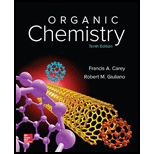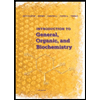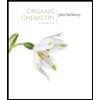
Organic Chemistry - Standalone book
10th Edition
ISBN: 9780073511214
Author: Francis A Carey Dr., Robert M. Giuliano
Publisher: McGraw-Hill Education
expand_more
expand_more
format_list_bulleted
Concept explainers
Textbook Question
Chapter 1.3, Problem 7P
Problem 1.7
All of the hydrogens are bonded to carbon in both of the following. Write a Lewis formula that satisfies the octet rule for each.
(a) Formaldehyde (
Expert Solution & Answer
Want to see the full answer?
Check out a sample textbook solution
Students have asked these similar questions
Question:
Consider a hypothetical molecule, X₄Y₃, composed of four atoms of element X and three atoms of element Y. The molecule is in a gaseous state.
a) According to the octet rule, which elements are likely to form multiple bonds in this molecule? Explain your reasoning.
b) Calculate the total number of valence electrons in X₄Y₃.
c) Based on the total number of valence electrons, determine the formal charge on each atom in X₄Y₃.
Answer the following question about esmolol (attached) , a drug used to treat high blood pressure sold under the trade name Brevibloc.
Question: Label all C's that bear a δ+ charge.
Question 15
Atom X in a molecule has tetrahedral electron geometry but a bent molecular shape. Which of the following describes the identity of atom X?
A.
Atom X is the carbon in a molecule of CH4.
B.
Atom X is the nitrogen in a molecule of NH3.
C.
Atom X is the hydrogen in a molecule of CH4.
D.
Atom X is the oxygen in a molecule of H2O.
Chapter 1 Solutions
Organic Chemistry - Standalone book
Ch. 1.1 - How many electrons does carbon have? How many are...Ch. 1.1 - Referring to the periodic table as needed, write...Ch. 1.2 - Species that have the same number of electrons are...Ch. 1.2 - Which of the following ions possess a noble gas...Ch. 1.2 - Prob. 5PCh. 1.3 - Prob. 6PCh. 1.3 - Problem 1.7 All of the hydrogens are bonded to...Ch. 1.4 - Problem 1.8 In which of the compounds...Ch. 1.4 - Indicate the direction of the dipole for the...Ch. 1.5 - Prob. 10P
Ch. 1.5 - The following inorganic species will be...Ch. 1.5 - Prob. 12PCh. 1.6 - Prob. 13PCh. 1.6 - Problem 1.14 Nitrosomethane and formaldoxime both...Ch. 1.6 - Prob. 15PCh. 1.7 - All of the bonds in the carbonate ion (CO32-) are...Ch. 1.7 - Prob. 17PCh. 1.8 - Prob. 18PCh. 1.8 - Prob. 19PCh. 1.9 - Sodium borohydride, NaBH4, has an ionic bond...Ch. 1.9 - Prob. 21PCh. 1.10 - Which of the following compounds would you expect...Ch. 1.11 - Using the curved arrow to guide your reasoning,...Ch. 1.11 - Prob. 24PCh. 1.11 - Prob. 25PCh. 1.12 - Prob. 26PCh. 1.12 - Prob. 27PCh. 1.12 - Prob. 28PCh. 1.12 - Prob. 29PCh. 1.12 - Prob. 30PCh. 1.13 - Which is the stronger acid, H2O or H2S? Which is...Ch. 1.13 - Prob. 32PCh. 1.13 - Prob. 33PCh. 1.13 - Hypochlorous and hypobromous acid (HOClandHOBr)...Ch. 1.13 - Prob. 35PCh. 1.13 - Prob. 36PCh. 1.14 - What is the equilibrium constant for the following...Ch. 1.14 - Prob. 38PCh. 1.14 - Prob. 39PCh. 1.15 - Write an equation for the Lewis acid/Lewis base...Ch. 1 - Write a Lewis formula for each of the following...Ch. 1 - Prob. 42PCh. 1 - Write structural formulas for all the...Ch. 1 - Prob. 44PCh. 1 - Expand the following structural representations so...Ch. 1 - Each of the following species will be encountered...Ch. 1 - Consider Lewis formulas A, B, and C: H2 C -NN:...Ch. 1 - Prob. 48PCh. 1 - Prob. 49PCh. 1 - Prob. 50PCh. 1 - Prob. 51PCh. 1 - Prob. 52PCh. 1 - Prob. 53PCh. 1 - Prob. 54PCh. 1 - Which compound in each of the following pairs...Ch. 1 - With a pKa of 11.6, hydrogen peroxide is a...Ch. 1 - The structure of montelukast, an antiasthma drug,...Ch. 1 - One acid has a pKa of 2, the other has a pKa of 8....Ch. 1 - Calculate Ka for each of the following acids,...Ch. 1 - Rank the following in order of decreasing acidity....Ch. 1 - Rank the following in order of decreasing...Ch. 1 - Consider 1.0 M aqueous solutions of each of the...Ch. 1 - Prob. 63PCh. 1 - Prob. 64PCh. 1 - Prob. 65PCh. 1 - Prob. 66PCh. 1 - Prob. 67PCh. 1 - Prob. 68PCh. 1 - Amide Lewis Structural Formulas Lewis formulas are...Ch. 1 - Amide Lewis Structural Formulas Lewis formulas are...Ch. 1 - Amide Lewis Structural Formulas Lewis formulas are...Ch. 1 - Prob. 72DSPCh. 1 - Amide Lewis Structural Formulas Lewis formulas are...Ch. 1 - Amide Lewis Structural Formulas Lewis formulas are...
Knowledge Booster
Learn more about
Need a deep-dive on the concept behind this application? Look no further. Learn more about this topic, chemistry and related others by exploring similar questions and additional content below.Similar questions
- I need answer for question 2.3 1. Draw three molecules of each compound, i.e. draw the molecules next to one another to visualize IMFa. Propane, CH3CH2CH3b. Heptane, CH3(CH2)5CH3 c. Propanol, CH3CH2CH2OH d. Heptanol, CH3(CH2)6OH2. For each compound, consider whether or not H-bonding can occur between its molecules. Use a dashed line to show any H-bonding.3. For each compound, consider whether or not any polar bonds are presenta. Use a different coloured pen to identify any polar bondsb. Which compounds are polar? Which compounds are nonpolar? Explain your reasoning4. Compare your drawings for propanol and heptanol.a. Which compound has stronger dispersion forces? Explain your answerb. Which compound has a higher boiling point? Explain your answer5. Compare your drawings of heptanes and heptanola. Which compound is more polar? Explain your answerb. Which compound is more soluble in water? Explain your answerarrow_forwardTrue or False? Circle your answer. a. The sum of all formal charges on a molecule is equal to the charge on the molecule or ion. True or False b. If the total charge on a molecule is zero, then each atom in the molecule has a formal charge of zero. True or Falsearrow_forward3-37 Answer true or false. (a) An ionic bond is formed by the combination of positive and negative ions. (b) An ionic bond between two atoms forms by the transfer of one or more valence electrons from the atom of higher electronegativity to the atom of lower electronegativity. (c) As a rough guideline, we say that an ionic bond will form if the difference in electronegativity between two atoms is approximately 1.9 or greater. (d) In forming NaCl from sodium and chlorine atoms, one electron is transferred from the valence shell of sodium to the valence shell of chlorine. (e) The formula of sodium sulfide is Na2S. (f) The formula of calcium hydroxide is CaOH. (g) The formula of aluminum sulfide is MS. (h) The formula of iron(III) oxide is Fe2O2. (j) Barium ion is Ba2, and oxide ion is O2-; there fore, the formula of barium oxide is Ba2O2.arrow_forward
- Predict the formula for a compound made from X+X+ and Y−Y−. Insert subscripts as needed: Formula: XYarrow_forwardPractice problem 1: Show a full octet resonance contributor for thymine, using curved arrows to show its contributor. Add all formal charges, if necessary.arrow_forwardWhich of the following are molecular formulas? Select all that apply. Group of answer choices C3H6O3 C2H6O C2H4O2 C3H9O2 CH2Oarrow_forward
- 3-64 Acetylene (C2H2), hydrogen cyanide (HCN), and nitrogen (N2) each contain a triple bond. Draw a Lewis structure for each molecule. Which of these are polar molecules, and which are nonpolar molecules?arrow_forwardConsider the molecule, SOCl2 How many bonding electron pairs are there in the central atom? (numerical answer only)arrow_forwardIf Oxygen has an atomic number of 8, then how many protons would a molecule of water (H2O) contain? (Hint: an H+ ion is a proton)arrow_forward
arrow_back_ios
SEE MORE QUESTIONS
arrow_forward_ios
Recommended textbooks for you
 Introduction to General, Organic and BiochemistryChemistryISBN:9781285869759Author:Frederick A. Bettelheim, William H. Brown, Mary K. Campbell, Shawn O. Farrell, Omar TorresPublisher:Cengage Learning
Introduction to General, Organic and BiochemistryChemistryISBN:9781285869759Author:Frederick A. Bettelheim, William H. Brown, Mary K. Campbell, Shawn O. Farrell, Omar TorresPublisher:Cengage Learning

Introduction to General, Organic and Biochemistry
Chemistry
ISBN:9781285869759
Author:Frederick A. Bettelheim, William H. Brown, Mary K. Campbell, Shawn O. Farrell, Omar Torres
Publisher:Cengage Learning

Nomenclature: Crash Course Chemistry #44; Author: CrashCourse;https://www.youtube.com/watch?v=U7wavimfNFE;License: Standard YouTube License, CC-BY